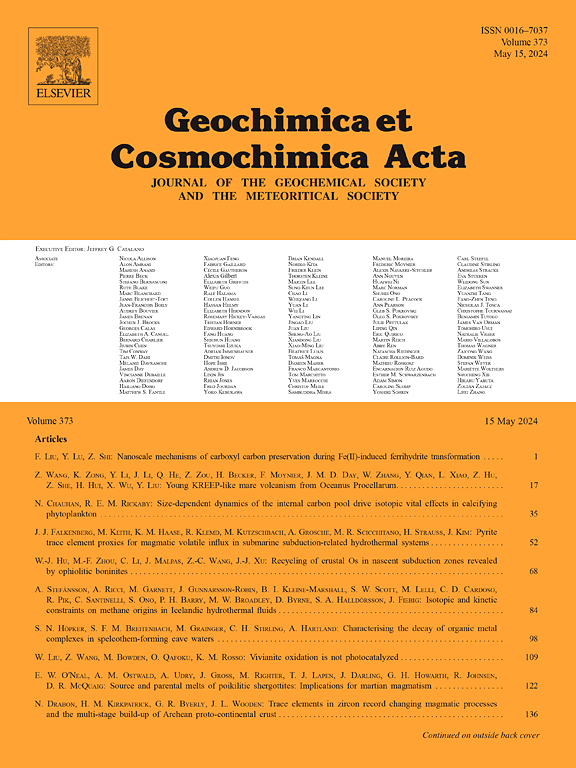未熔化的难熔夹杂物中初始26Al/27Al的高精度SIMS分析:寻找多重冷凝事件
IF 4.5
1区 地球科学
Q1 GEOCHEMISTRY & GEOPHYSICS
引用次数: 0
摘要
在太阳系演化的早期阶段,高温事件形成的难熔包裹体。包裹体中短寿命放射性核素系统的研究为这些热事件的时间和性质提供了限制。来自CV (Vigarano型)碳质球粒陨石的7个未熔化的难熔夹杂物(细晶富尖晶石和蓬松型a CAIs)的初始26Al/27Al比值[(26Al/27Al)0]的高精度SIMS数据(我们将其解释为初级星云凝聚物或其非常接近的衍生物)得出了6个接近5.2 × 10 - 5的标准比值,1个略低,但仍几乎在5.0 × 10 - 5的误差范围内。我们专门寻找但没有发现像Kawasaki等人(2020)最近报道的低得多的值,低至3.4 × 10-5。从年代学的角度来看,我们和其他人在过去15年中积累的高精度数据显示,正常的富26Al CAIs没有明显的凝结事件,对应于(3-4)× 10-5的(26Al/27Al)0。相反,在(26Al/27Al)0 = 5.2 × 10-5的cai形成区,似乎发生了一次主要的热事件,导致了广泛的蒸发和冷凝,从而形成了大多数正常的难熔包体前体。在随后的~ 20万年里,随后发生的较小的事件导致了许多冰川的热变质和融化。Kawasaki等人(2020)研究的包裹体可能形成于cai形成区域中显著同位素混合之前的早期事件中,或者在陨石记录中没有很好地代表的热事件中,比大多数难熔包裹体更晚。以低(26Al/27Al)0, <;1 × 10-5为特征的难熔包裹体,如FUN(分选和未识别的核效应)包裹体,PLACs(片状Hibonite晶体),以及一些刚玉,Hibonite和富含粗石的cai形成于更早的加热事件中,可能在早期太阳系26Al均质化之前形成。这些物体的初始26Al/27Al值没有提供定量的时间限制。本文章由计算机程序翻译,如有差异,请以英文原文为准。
High-precision SIMS analyses of initial 26Al/27Al in un-melted refractory inclusions: The search for multiple condensation episodes
Refractory inclusions formed via high temperature events during the earliest stages of the solar system evolution. Studies of short-lived radionuclide systems in the inclusions provide constraints on the timing and nature of these thermal events. High-precision SIMS data for initial 26Al/27Al ratio [(26Al/27Al)0] in a suite of seven un-melted refractory inclusions (fine-grained spinel-rich and Fluffy Type A CAIs) from CV (Vigarano type) carbonaceous chondrites – which we interpret as primary nebular condensates or their very close derivatives – yield six values close to the canonical ratio of 5.2 × 10−5 and one marginally lower but still almost within error of 5.0 × 10–5. We specifically looked for but did not find much lower values like those reported recently by Kawasaki et al. (2020), as low as 3.4 × 10–5. Interpreted in terms of chronology, the accumulated high precision data acquired by us and others within the past 15 years for normal, 26Al-rich CAIs show no evidence for a significant condensation event that would correspond to (26Al/27Al)0 of (3–4) × 10–5. Rather, there appears to have been one major thermal event resulting in extensive evaporation and condensation in the CAI-forming region corresponding to (26Al/27Al)0 of 5.2 × 10–5 resulting in formation of most normal refractory inclusion precursors. Subsequent smaller events over the succeeding ∼200,000 years caused thermal modification and melting of many of them. Inclusions such as that studied by Kawasaki et al. (2020) could have formed either in an early event prior to significant isotopic mixing in the CAI-forming region, or later than most refractory inclusions during a thermal event that is not well represented in the meteorite record. Refractory inclusions characterized by low (26Al/27Al)0, <1 × 10–5, such as FUN (Fractionation and Unidentified Nuclear effects) inclusions, PLACs (Platy Hibonite Crystals), and some corundum-, hibonite-, and grossite-rich CAIs formed during a much earlier heating event, likely prior to homogenization of 26Al in the early solar system. The initial 26Al/27Al values of such objects provide no quantitative chronological constraints.
求助全文
通过发布文献求助,成功后即可免费获取论文全文。
去求助
来源期刊

Geochimica et Cosmochimica Acta
地学-地球化学与地球物理
CiteScore
9.60
自引率
14.00%
发文量
437
审稿时长
6 months
期刊介绍:
Geochimica et Cosmochimica Acta publishes research papers in a wide range of subjects in terrestrial geochemistry, meteoritics, and planetary geochemistry. The scope of the journal includes:
1). Physical chemistry of gases, aqueous solutions, glasses, and crystalline solids
2). Igneous and metamorphic petrology
3). Chemical processes in the atmosphere, hydrosphere, biosphere, and lithosphere of the Earth
4). Organic geochemistry
5). Isotope geochemistry
6). Meteoritics and meteorite impacts
7). Lunar science; and
8). Planetary geochemistry.
 求助内容:
求助内容: 应助结果提醒方式:
应助结果提醒方式:


